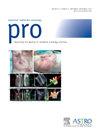针对复发性乳腺癌的抢救性保乳手术和术中电子再照射:代表意大利放射治疗和临床肿瘤学协会(AIRO)进行的一项多中心研究。
IF 3.4
3区 医学
Q2 ONCOLOGY
引用次数: 0
摘要
目的:术中电子放疗(IOERT)可能是原发性乳腺癌(BC)局部复发(LR)重复四维切除术后乳房部分再照射(rePBI)的可行选择,以代替乳房切除术:2016年至2018年,建立了一个数据库,收集了8个意大利中心的IOERT再照射数据,提供了第2次局部复发的累积发生率(CumI)和长期随访的生存率(FU)数据。 结果:2002年至2015年,109名患者接受了保守再治疗。原发性 BC-1 1stLR 的中位间隔为 11.1 年(范围:2.4-27.7)。IOERT 中位剂量为 18 Gy(范围:12-21),中位准直器为 4 cm(范围:3-6)。中位FU为11.7年(四分位间范围:7.7-14.6)。5年后第2次LR的CumI为12.2%(95% CI:6.8-19.2),10年后为32.3%(95% CI:22.8-42.2),约半数病例的第2次LR发生在第1次LR的同一部位。HER2状态和准直器大小是独立的LR预测因素。5年和10年总生存率分别为95.2%和88.3%,5年和10年BC特异性生存率分别为98%和94.5%。第2次LR的出现明显降低了BCSS(HR=9.40,PConclusion):第2次LR的CumI在文献范围内,但高于预期,这对放射野扩展和分次计划提出了质疑。由于第2次LR会使结果恶化,因此必须仔细规划挽救方式。本文章由计算机程序翻译,如有差异,请以英文原文为准。
Salvage Breast-Conserving Surgery and Reirradiation With Intraoperative Electrons for Recurrent Breast Cancer: A Multicentric Study on Behalf of Italian Association of Radiotherapy and Clinical Oncology (AIRO)
Purpose
Intraoperative radiation therapy with electrons (IOERT) may represent a viable choice for partial breast reirradiation after repeat quadrantectomy for local recurrence (LR) for primary breast cancer (BC) in lieu of mastectomy.
Methods and Materials
A database collecting data on partial breast reirradiation with IOERT from 8 Italian centers was set up in 2016 to 2018, providing data on cumulative incidence (CumI) of second LR and survival with a long follow-up.
Results
From 2002 to 2015, 109 patients underwent the conservative retreatment. The median primary BC first LR interval was 11.1 years (range, 2.4-27.7). The median first LR size was 0.9 cm (range, 0.3-3.0), and 43.6% cases were luminal A. Median IOERT dose was 18 Gy (range, 12-21), and median collimator diameter was 4 cm (range, 3-6). Median follow-up duration was 11.7 years (IQR, 7.7-14.6). The second LR CumI was 12.2% (95% CI, 6.8%-19.2%) at 5 years and 32.3% at 10 years (95% CI, 22.8%-42.2%), occurring in the same site as the first LR in about half of the cases. Human epidermal growth factor receptor 2 status and collimator size were independent LR predictors. The 5- and 10-year overall survival rates were 95.2% and 88.3%, respectively, whereas 5- and 10-year BC-specific survival rates were 98% and 94.5%, respectively. The development of a second LR significantly reduced BC-specific survival (hazard ratio, 9.40; P < .001). Grade ≥3 fibrosis rate was 18.9%. Patient-reported cosmesis was good/excellent in 59.7% of the cases.
Conclusions
Second LR CumI was within the range of the literature but higher than expected, opening questions on radiation field extension and fractionation schedule. Because a second LR worsened the outcome, salvage modality must be carefully planned.
求助全文
通过发布文献求助,成功后即可免费获取论文全文。
去求助
来源期刊

Practical Radiation Oncology
Medicine-Radiology, Nuclear Medicine and Imaging
CiteScore
5.20
自引率
6.10%
发文量
177
审稿时长
34 days
期刊介绍:
The overarching mission of Practical Radiation Oncology is to improve the quality of radiation oncology practice. PRO''s purpose is to document the state of current practice, providing background for those in training and continuing education for practitioners, through discussion and illustration of new techniques, evaluation of current practices, and publication of case reports. PRO strives to provide its readers content that emphasizes knowledge "with a purpose." The content of PRO includes:
Original articles focusing on patient safety, quality measurement, or quality improvement initiatives
Original articles focusing on imaging, contouring, target delineation, simulation, treatment planning, immobilization, organ motion, and other practical issues
ASTRO guidelines, position papers, and consensus statements
Essays that highlight enriching personal experiences in caring for cancer patients and their families.
 求助内容:
求助内容: 应助结果提醒方式:
应助结果提醒方式:


